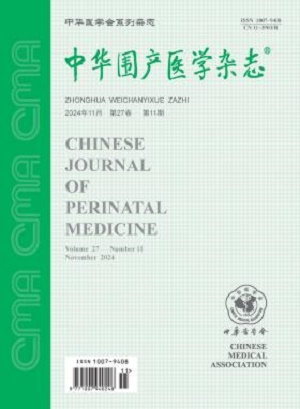新生儿红斑狼疮13例临床分析
Q4 Medicine
引用次数: 0
摘要
目的总结新生儿红斑狼疮(NLE)的临床特点,提高临床认识。方法回顾性分析2010年9月至2017年9月在福建省妇幼医院住院的13例NLE患者的临床资料。综述了这些婴儿的发病机制、临床表现、实验室检查、治疗和长期疗效,并对相关文献进行了综述。进行描述性统计分析。结果13例NLE患者包括8名男孩和5名女孩。其中,皮肤病变、心脏损伤、血液系统问题、肝胆系统损伤、中枢神经系统受累和肾功能损害分别发生在8例、7例(6例为房室传导阻滞)、7例、3例、1例和1例。抗核抗体和抗干燥综合征抗原A抗体在所有新生儿中均呈阳性,抗干燥综合症抗原B抗体在11例中呈阳性,而抗双链DNA抗体在2例中呈阴性。在13名母亲中,3名被诊断为干燥综合征,2名在怀孕前患有系统性红斑狼疮(SLE),2名被诊断患有干燥综合征和1名在怀孕期间患上SLE。8名有皮肤损伤的婴儿被要求避光,皮疹在出生后1-6个月内逐渐消退。5例血小板减少症患者接受静脉注射免疫球蛋白治疗,1例贫血婴儿接受红细胞输注。在2至3个月内,这些婴儿受损的血液系统恢复正常。对于三个肝功能异常的婴儿,给予肝脏保护剂和黄疸缓解剂,2至6个月后他们康复了。13例患者随访5个月至7年,其中7例生长发育正常,病情好转;5例仍有Ⅲ级房室传导阻滞;其中一例在11个月时安装了心房起搏器。三名在怀孕期间无症状的母亲在其婴儿被诊断为NLE后被发现患有自身免疫性疾病,其中包括一例干燥综合征和两例系统性红斑狼疮。结论NLE主要表现为皮肤病变和先天性心脏传导阻滞,肝脏、血液系统、中枢神经系统等器官也可能受累。对于高危母婴,建议及时进行自身抗体筛查和相关检查,进行早期诊断和干预。此外,还需要对受影响的病例进行长期随访。关键词:系统性红斑狼疮;婴儿、新生儿本文章由计算机程序翻译,如有差异,请以英文原文为准。
Neonatal lupus erythematosus: clinical analysis of 13 cases
Objective
To summarize the clinical features of neonatal lupus erythematosus (NLE) and to have a better clinical understanding.
Methods
We retrospectively analyzed the clinical data of 13 patients with NLE who were hospitalized in Fujian Provincial Maternity and Children's Hospital from September 2010 to September 2017. The pathogenesis, clinical manifestations, laboratory examinition, management and long term outcomes of these babies were summarized, and the relevant literatures were also reviewed. Descriptive statistical analysis was performed.
Results
The 13 NLE cases included eight boys and five girls. Among them, skin lesions, cardiac impairment, hematological problems, hepatobiliary system damage, central nervous system involvement and renal function damage occurred in eight, seven (six cases were atrioventricular block), seven, three, one and one case, respectively. Antinuclear antibodies and anti-Sjogren's syndrome antigen A antibodies were positive in all neonates, anti-Sjogren's syndrome antigen B antibodies were positive in 11, and anti-double-stranded DNA antibodies were positive in two cases. Among the 13 mothers, three were diagnosed with Sjogren's syndrome and two had systemic lupus erythematosus(SLE) before pregnancy, two were diagnosed with Sjogren's syndrome and one developed SLE during pregnancy. Eight babies with skin lesions were asked to avoid light and the skin rash all gradually receded within 1-6 months after birth. Five cases with thrombocytopenia were treated with intravenous immunoglobulin and one anemic baby received erythrocyte transfusion. Within 2 to 3 months, the impaired blood system in these babies were back to normal. For the three babies with abnormal liver functions, hepatic protectants and jaundice relieving agents were given, and 2 to 6 months later they recovered. The 13 patients were followed up for five months to seven years, among which, seven improved with normal growth and development; five still had grade Ⅲ atrioventricular block; one installed an atrial pacemaker at 11 months. Three mothers who were asymptomatic during pregnancy were found to have autoimmune diseases after their babies were diagnosed with NLE, including one case of Sjogren's syndrome and two of SLE.
Conclusions
NLE is mainly characterized by skin lesions and congenital heart block, while liver, blood system, central nervous system and other organs may also be involved. For high-risk mothers and babies, timely autoantibody screening and relevant examinations are suggested for early diagnosis and interventions. In addition, long term follow-up is required for affected cases.
Key words:
Lupus erythematosus, systemic; Infant, newborn
求助全文
通过发布文献求助,成功后即可免费获取论文全文。
去求助
来源期刊

中华围产医学杂志
Medicine-Obstetrics and Gynecology
CiteScore
0.70
自引率
0.00%
发文量
4446
期刊介绍:
Chinese Journal of Perinatal Medicine was founded in May 1998. It is one of the journals of the Chinese Medical Association, which is supervised by the China Association for Science and Technology, sponsored by the Chinese Medical Association, and hosted by Peking University First Hospital. Perinatal medicine is a new discipline jointly studied by obstetrics and neonatology. The purpose of this journal is to "prenatal and postnatal care, improve the quality of the newborn population, and ensure the safety and health of mothers and infants". It reflects the new theories, new technologies, and new progress in perinatal medicine in related disciplines such as basic, clinical and preventive medicine, genetics, and sociology. It aims to provide a window and platform for academic exchanges, information transmission, and understanding of the development trends of domestic and foreign perinatal medicine for the majority of perinatal medicine workers in my country.
 求助内容:
求助内容: 应助结果提醒方式:
应助结果提醒方式:


